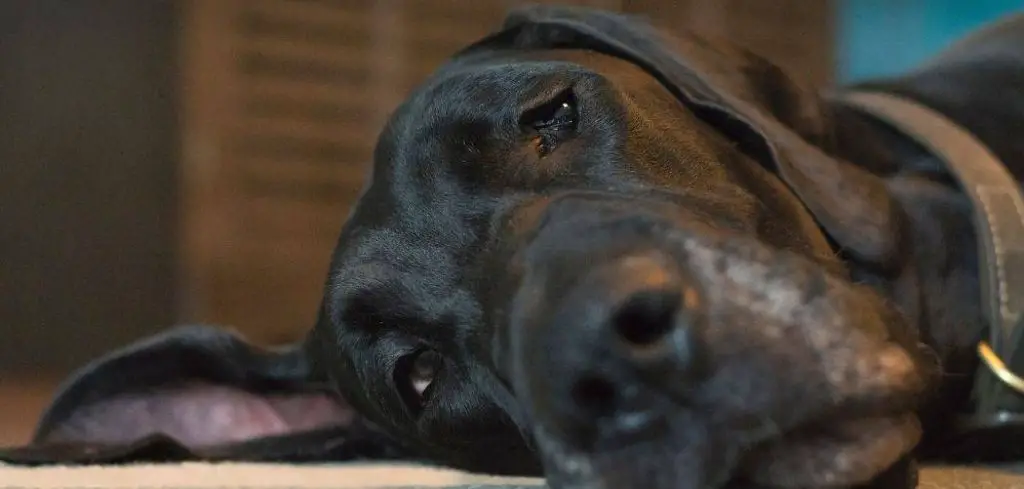When your dog is laying around and not eating, it’s easy to feel worried and unsure of what’s going on. These symptoms may seem subtle at first, but they can point to a range of underlying health or emotional issues that shouldn’t be ignored.
We outline the common causes of dog laying around and not eating, what you can do at home, and when to seek veterinary help.
Dog Laying Around and Not Eating — Why It Happens
When your dog is lethargic and losing interest in food, it’s often a sign that something is wrong internally.
It could be as simple as an upset stomach or as serious as a systemic illness like kidney failure or heart disease. Pain, infections, poisoning, or even emotional distress can all cause your dog to withdraw and stop eating.
In older dogs, age-related conditions like arthritis or organ decline can contribute to these symptoms. Puppies and young dogs may act this way due to infections like parvovirus or parasites.

Common Causes of Dog Laying Around and Not Eating
Gastrointestinal Upset
A common cause of lethargy and appetite loss in dogs is gastrointestinal discomfort.
Dogs who’ve eaten something spoiled, toxic, or indigestible may suffer from nausea, bloating, or abdominal pain.
This discomfort often leads to decreased activity and refusal to eat. Vomiting, diarrhea, and gurgling stomach sounds may accompany the symptoms.
While mild cases resolve on their own, persistent signs could indicate something more serious like pancreatitis or intestinal blockage.
Infections
Viral or bacterial infections can take a heavy toll on a dog’s energy and appetite.
Conditions like kennel cough, leptospirosis, or parvovirus often cause dogs to become listless and uninterested in food.
Fever, vomiting, diarrhea, and nasal discharge may also appear. Infections tax the immune system, leaving dogs too tired to engage or eat.
Prompt diagnosis and treatment are essential, especially in puppies and immunocompromised dogs.
Pain or Injury
Physical pain from injuries or chronic conditions can lead dogs to isolate and stop eating.
Dogs are experts at hiding pain, but when discomfort becomes overwhelming, they may become inactive and avoid food.
Common causes include sprains, fractures, dental pain, or arthritis.
A dog in pain might also pant, whine, lick excessively at one area, or avoid being touched.
If your dog suddenly becomes still and avoids meals, an undiagnosed injury could be the reason.
Heatstroke or Overheating
In hot climates or during intense activity, dogs can suffer from heat exhaustion.
Lethargy and loss of appetite are early warning signs. Heatstroke progresses quickly and can cause vomiting, excessive panting, bright red gums, and even collapse.
Dogs with thick coats, flat faces (like Bulldogs or Pugs), or underlying health issues are at higher risk. Immediate cooling and vet care are crucial.
Organ Dysfunction (Kidney or Liver Disease)
When the kidneys or liver begin to fail, the buildup of toxins affects the entire body.
Dogs with chronic kidney or liver disease often feel nauseous, tired, and uninterested in food.
Other signs may include bad breath, yellowing of the eyes or gums, increased thirst, and weight loss.
These conditions can progress slowly, making them harder to detect in the early stages.
Routine bloodwork can help catch these issues before they worsen.
Read more: Old dog eating and sleeping a lot (Here’s why)
Emotional or Environmental Stress
Dogs are sensitive to changes in their environment or emotional state.
Major changes like moving homes, new family members, or even loud noises can lead to anxiety or depression in dogs.
In response, they may lay around more and stop eating. Other signs might include whining, pacing, hiding, or destructive behavior.
If your dog’s behavior shifted after a specific event, emotional stress may be the cause.
What to Do If Your Dog Is Laying Around and Not Eating
If your dog seems tired and is skipping meals, start by monitoring closely for other symptoms.
Check their gums for color and hydration. Offer bland food like boiled chicken and rice to see if they’ll eat something gentle.
Ensure they have access to fresh, cool water. Try engaging them with toys or a walk to assess energy levels.
If they’ve recently experienced stress, comfort them in a quiet space and give them time to adjust.
Rest is helpful in mild cases, but don’t wait too long to intervene. If symptoms persist beyond a day or two, or your dog refuses all food, it’s time to call your vet.
Keep a record of any vomiting, diarrhea, or changes in behavior to help your vet make a more accurate diagnosis.
When to Call or Visit Your Vet
Contact your veterinarian right away if your dog:
Has not eaten anything for more than 24–48 hours
Appears weak, wobbly, or struggles to stand
Is vomiting, has diarrhea, or both
Shows signs of pain like whining, panting, or limping
Has a swollen abdomen or bloating
Is running a fever (above 103°F)
Even if your dog perks up briefly, recurring symptoms are a red flag. Don’t hesitate to seek help—early diagnosis often leads to better outcomes.
Read more: Old dog eating and sleeping a lot (Should you worry?)
Key Takeaway
A dog who’s laying around and not eating is trying to tell you something isn’t right.
It could be physical pain, a hidden illness, or emotional stress.
While some cases resolve on their own, others can escalate quickly if left unchecked. Monitor closely, offer supportive care at home, and trust your instincts.
If in doubt, call your vet—it’s always better to be safe when your dog’s health is at stake.
